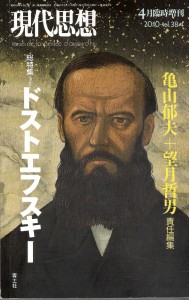I have a new publication, but unfortunately I fear that most of my readers will be as incapable of reading it as I am:
‘“Hakuchi” to Holbein “Hakano nakano Kirisuto”,’ Gendai Shiso, 38.4 (2010), 298-307. That’s ‘Holbein’s Christ inthe Tomb in The Idiot‘, translated by Kyohei Norimatsu (to whom many thanks) in a special Dostoevsky issue of the journal Contemporary Thought, edited by Ikuo Kameyama and Tetsuo Mochizuki.
In the article I look at the role of Holbein’s painting Christ in the Tomb as a structuring device in The Idiot. The painting, I think, still has the power to shock, and as is well known, it is central in the novel to questions about the nature of the hero, Prince Myshkin and his relationship to the figure of Christ. A great deal has already been written about that, but my interest when I was working on The Idiot was in the interactions of the characters and how that affected the narrative form, which everybody agrees is rather strange, with part 1 taking place over a single day and parts 2-4 covering a two or three week period six months later. I argue that the two appearances of the painting, close to the beginning of part 2 and towards the end of part 3, frame the central section, where the novel seems quite literally to lose the plot, because of the impact it has on the hero.
It’s a bit more complicated than that, but if you do want to read it, fortunately it’s available in English: ‘Holbein’s Christ in the Tomb in the Structure of The Idiot,’ Russian Studies in Literature, 44.1 (2007-8), 90-102; and in Russian: ‘Kartina Gol’beina “Khristos v mogile” v strukture romana “Idiot”, trans. Tat’iana Kasatkina, in T.A. Kasatkina, ed., Roman Dostoevskogo ‘Idiot’: Sovremennoe sostoianie izucheniia (Moscow: Nasledie, 2001), 28-39. I’m taking bets on what language it’ll be translated into next.
Dostoevsky studies is, as ever, thriving in Japan, and the journal as a whole looks good, with a big selection of essays by Japanese and international scholars. I just wish I could read it.


1 Comment